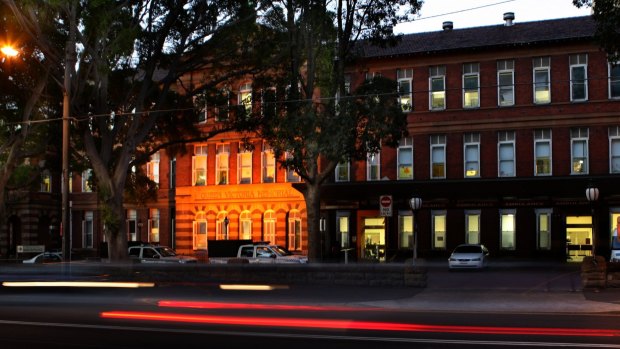This was published 9 years ago
RPA hospital investigates private partnerships to relieve pressure on wards
By Harriet Alexander and Health reporter
Royal Prince Alfred Hospital is seeking out partnerships with the private sector to relieve pressure on its bulging wards, as it braces itself for an influx in patients over the next 10 years.
But local health administrators have warned the NSW government that without investing in new buildings and equipment, the hospital will be unable to meet its core demands.
Sydney Local Health District has asked the NSW government for $702 million to redevelop RPA, which has run out of physical space to cope with an anticipated 85 per cent increase in emergency admissions and demand for about 200 extra ward beds by 2027.
The 2015 Asset Strategic Plan, which was obtained by the NSW opposition under freedom of information laws, recommended a campus redevelopment that moved all non-acute services to the western side of Missenden road, to create space for the growth of acute services.

Royal Prince Alfred Hospital needs works urgently to cope with emergency demand.Credit: Michele Mossop
The last redevelopment of the 136-year-old hospital only catered for growth up to 2006 and it was now performing over capacity, the report said.
The hospital was experiencing "severe bed blockages", whereby patients banked up in the emergency department because there were no spare beds on the wards.
This was due to the pediatric in-patient unit having no surge capacity, the discharge lounge being too small and the constraints of the emergency department itself, which was housed in a heritage building bounded by imaging services and had no room to expand.
An estimated 58 new treatment spaces would be required in the emergency department on top of 2011 levels by 2027.
"There are major capacity issues for maternity services, delivery rooms, beds and clinics," the report said. "Key departments have grown and are relatively land locked."
A lack of beds and theatre space has compelled the hospital to offload some of its services to the private sector, with the Chris O'Brien Lifehouse now providing all cancer treatments and outsourcing some of its theatres to RPA doctors.
The report identified opportunities for more public-private collaborations, including privately financed infrastructure being leased back by the hospital and the possibility of a private operator providing affordable patient accommodation.
Unless the campus was redeveloped the hospital would be unable to service demand from its immediate catchment, fail to meet its targets and hospital acquired infections would increase.
RPA currently has a lower rate of hospital acquired infections than the state average.
Labor health spokesman Walt Secord said the reference to infection control was "very worrying".
"Breakdown in infection control occurs when there is overcrowding of patients, cutbacks in cleaning and an increased workload."
Health Minister Jillian Skinner said the RPA redevelopment was on NSW Health's 10-year plan, "which indicates it will proceed".
"The risks listed in Sydney Local Health District's 2015 Asset Strategic Plan are clearly stated as risks only if the development does not proceed," Mrs Skinner said.
A spokeswoman for NSW Health said private partnerships were an effective way to deliver health services and non-government organisations had previously been contracted to provide medical imaging maintenance, pharmacy, non-urgent transport, laundry and cleaning services.
"Public Private Partnership hospital projects have proved beneficial in being able to deliver certain services at a reduced initial capital cost over what the government has been able to deliver," she said.
"Additionally, construction timeframes tend to be shorter and life-cycle maintenance is built into the pricing of the projects.
"PPP arrangements do not mean fewer resources for public patients."
A spokeswoman for the Sydney district said RPA was constantly reviewing service and capital works to ensure it met the needs of the community.
It was meeting its targets for elective surgery and improving its emergency performance.
According to the NSW Bureau of Health Information, RPA's emergency performance was stable throughout 2015, with about 63 per cent of patients leaving the department within four hours.
The NSW target is 80 per cent.
Do you know more? Contact halexander@smh.com.au